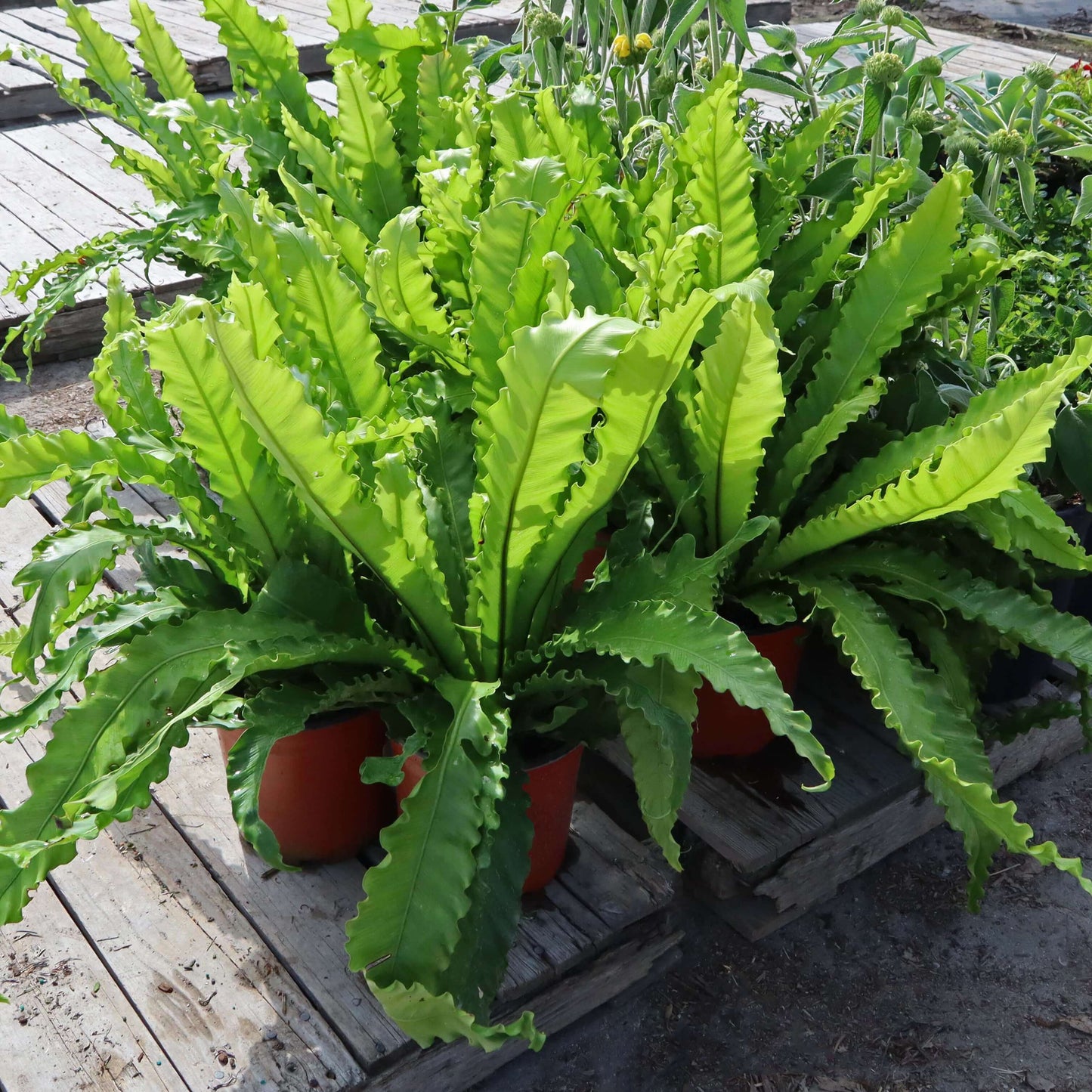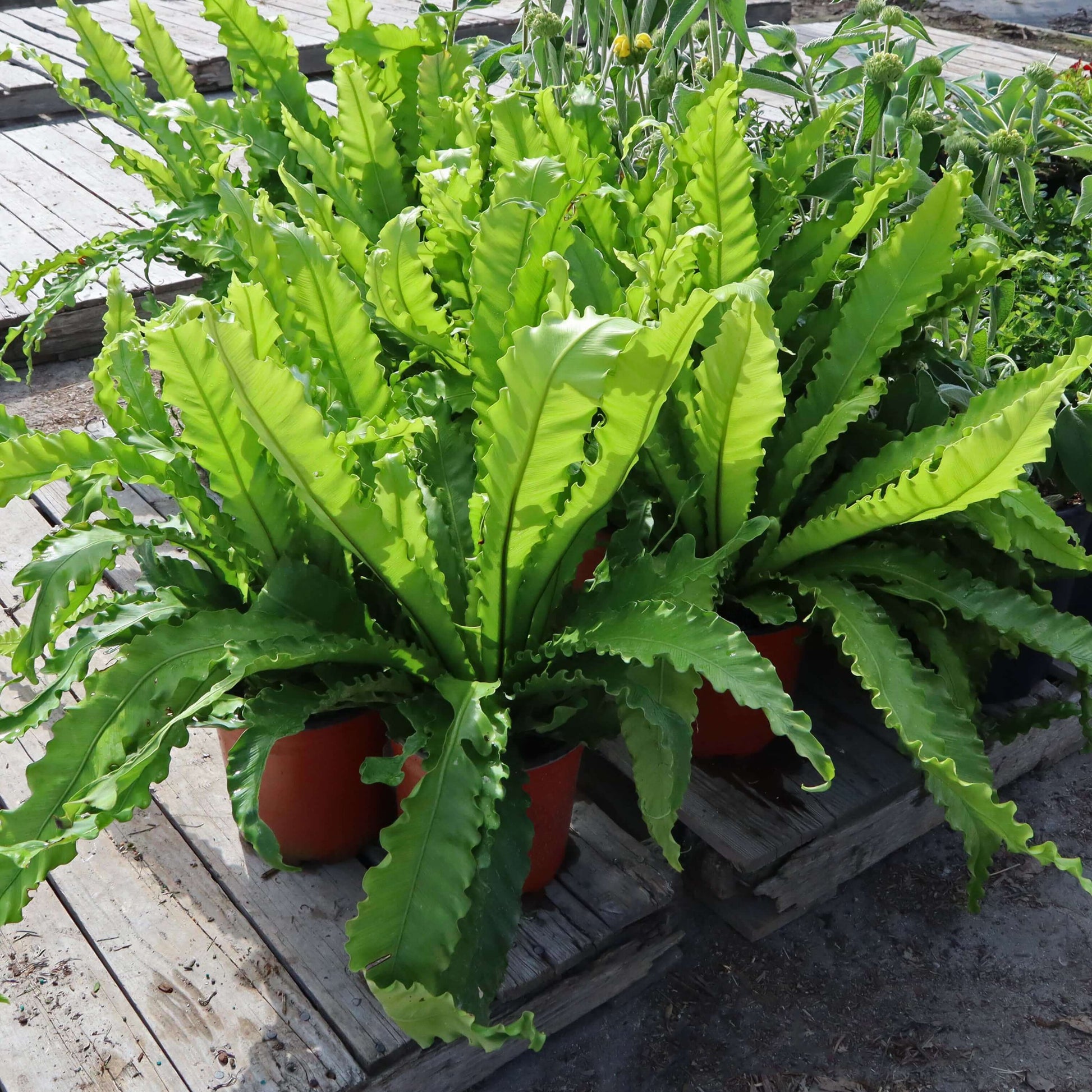Asplenium antiquum 'Victoria'
*All orders eligible for $20 flat-rate delivery. Go ahead, plant your heart out!
Victoria Bird's Nest Fern
Victoria Bird's Nest Fern
Asplenium antiquum 'Victoria'
Couldn't load pickup availability
Asplenium antiquum 'Victoria' is a stunning fern with foliage unlike the typical fern. The elegant, undivided, bright green polished leaves have ruffled edges that dazzle in any home or garden.
Bird’s Nest Ferns are popular ferns that can be grown in frost-free gardens or as a houseplant. There are several species in cultivation that are commonly called Bird’s Nest Ferns including Asplenium nidus, A. antiquum, and A. australasicum. The overlapping fronds radiate upward and outward in a rosette from the center of the fern forming a bowl-like depression in the middle that resembles a bird’s nest.
Also known as Wavy Japanese Bird’s Nest Fern, Victoria Bird’s Nest Fern is a semi-tender fern with undulating leaf margins. This medium sized fern is more compact and more robust and has narrower fronds and a better shape than the common bird’s nest fern (A. nidus or A. australasicum).
For a striking focal point, plant Victoria Bird’s Nest Fern in a frost-free shady location in the garden, or on the porch or patio in a pot. Can also be grown indoors in bright, indirect light.
Asplenium antiquum 'Victoria' is a graceful fern with lush, lustrous, frilly fronds and a distinctive shape that is sure to make a statement indoors or outdoors.
Asplenium antiquum 'Victoria' prefers well-draining, fertile soil and requires regular watering to keep the soil moist but not waterlogged. Water the soil of the outer edge of the fern, do not apply water in the center of the fern or the “nest” as this can lead to rot. Temperature, light intensity, soil moisture, and humidity, all contribute to the stress or success of your fern.
This fern thrives in bright, indirect light and can be grown in filtered shade. Protect from drying winds, direct sunlight, and cold temperatures.
Asplenium nidus 'Victoria' is a semi-tender evergreen fern suited for USDA growing zones 10-11 in frost-free climates. Semi-tender ferns grow best where nighttime temperatures are mostly above 50℉, where freezing temperatures are rare. Frost may discolor, damage, or kill the fern depending on the duration of the low temperatures. Semi-tender ferns grow well in coastal California.
Pruning is not necessary, but any dead or damaged fronds can be removed at the base to improve the plant's appearance. Protect from snails and slugs. With the right conditions, Victoria Bird’s Nest Fern is easy to grow and low maintenance in frost-free climates.
For indoor care, keep your fern out of direct sunlight, it prefers medium to bright indirect light. Direct sunlight will burn and discolor the fronds. Consistent moisture is key, do not allow your Victoria Bird’s Nest Fern to dry out and do not overwater. Apply the water directly to the soil, do not water the “nest” in the middle of the fern. Fertilize your house fern once a month during spring and summer. House ferns grow slower inside the house than in the wild. Repot into a slightly larger pot with fresh soil if the fern is looking too large or if your fern appears to be struggling from overwatering.
Asplenium antiquum 'Victoria' is the same plant as A. nidus ‘Victoria’, as it is sometimes incorrectly identified by a few in the trade.
A distinguishable difference between the bird’s nest ferns, Asplenium antiquum ‘Victoria’, Asplenium nidus, and Asplenium australasicum, upon close inspection, is the shape of the midrib as seen from both sides of the frond. Asplenium antiquum’s midrib is rounded, equal height and depth on both sides of the frond. The midribs of the other species are more elongated on one side. Asplenium australasicum has a deeply elongated midrib on the underside of the frond. Asplenium nidus has a taller elongated midrib on the topside of the frond.
Flat Rate
All orders have a flat rate delivery fee of $20.
Quality
Delivering premium quality plants is a core value for everyone at Plants Express. Whether it is a small plant or a large tree, we use the appropriate vehicles and team members to deliver your order in a timely manner.
Our Commitment:
As part of our unwavering dedication to sustainability, we take great pride in delivering your plants and trees without the use of any cardboard boxes. Furthermore, we utilize our own fleet of eco-friendly vans to ensure that we uphold our commitment to sustainable practices throughout every stage of the delivery process.
Our commitment to your satisfaction goes beyond just reducing waste and emissions, as we guarantee that your products are in the capable hands of our expert team members. With their careful attention and exceptional skills, your plants and trees will arrive in immaculate condition, ready to thrive in your care.

Q: Why is my Bird’s Nest Fern wilting?
A: Bird’s Nest Ferns need consistent moisture. Wilting can be caused by either lack of water, overwatering, or incorrect watering. Tempting as it is to water in the middle of the fern, watering the “nest” leads to rot. Water the soil around the outer edges into the fern.
Q: Why are the leaves of my Bird’s Nest Fern pale yellowish-green?
A: Your fern may be exposed to too much light or is in direct sunlight which can result in pale, yellowish leaves. Move the fern to a location with medium indirect light.
Q: Why are the leaves of my Bird’s Nest Fern brown at the edges?
A: Brown edges on the leaves of the Bird’s Nest Fern are generally caused by underwatering, temperature is too cold, or air is too dry. Consistent soil moisture is best, not wet soggy soil. Keep your fern away from air conditioners, heaters, vents, or drafty windows that will alter the temperature and humidity levels.
-
At Plants Express, we specialize in delivering the highest quality plants grown specifically for California's unique climate and conditions.
-
Our plants are hand-selected by our team of experts to ensure that only the best plants are procured for our customers.
-
We monitor each plant from the moment it's selected until the moment it arrives at your location to ensure that it arrives in the best possible condition.
For over 20 years, we’ve provided the finest plants and trees for California’s beautiful homes and landscapes. With more than 10 million trees and shrubs delivered and in the ground, we are California’s premier online nursery. We inspect every item for adherence to our stringent quality standards. From there, your plants are carefully loaded into our specially outfitted sprinter vans. If you need more mature trees and shrubs, we have a fleet of trucks for large deliveries. No more chasing after plants and carting them home. No more dried out or damaged plants arriving in boxes. With Plants Express, you can get everything you need in just a few clicks, from the comfort of your home.
Do you need help?
Our friendly plant experts are here to help. Give us a call or chat with us now.


